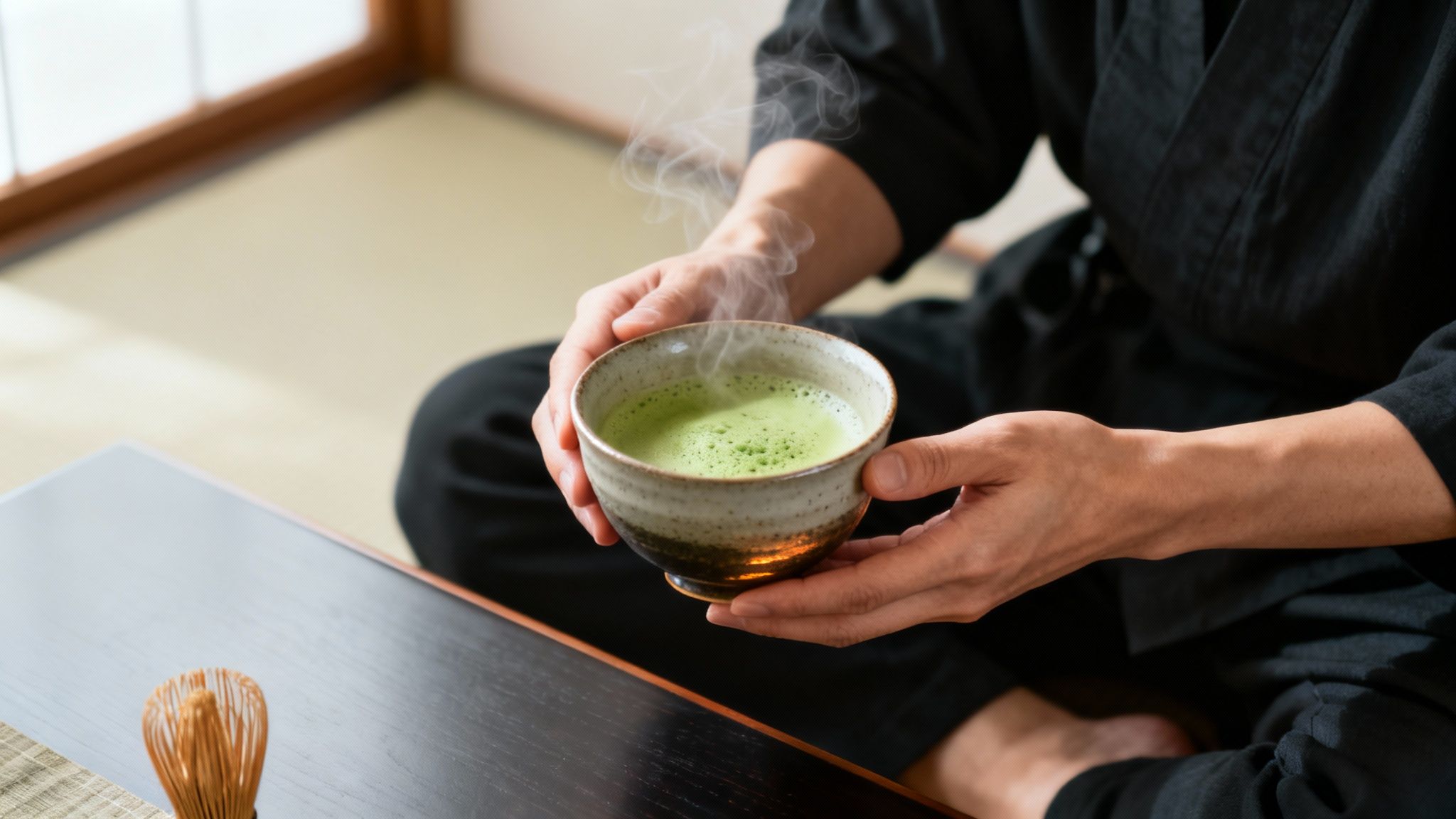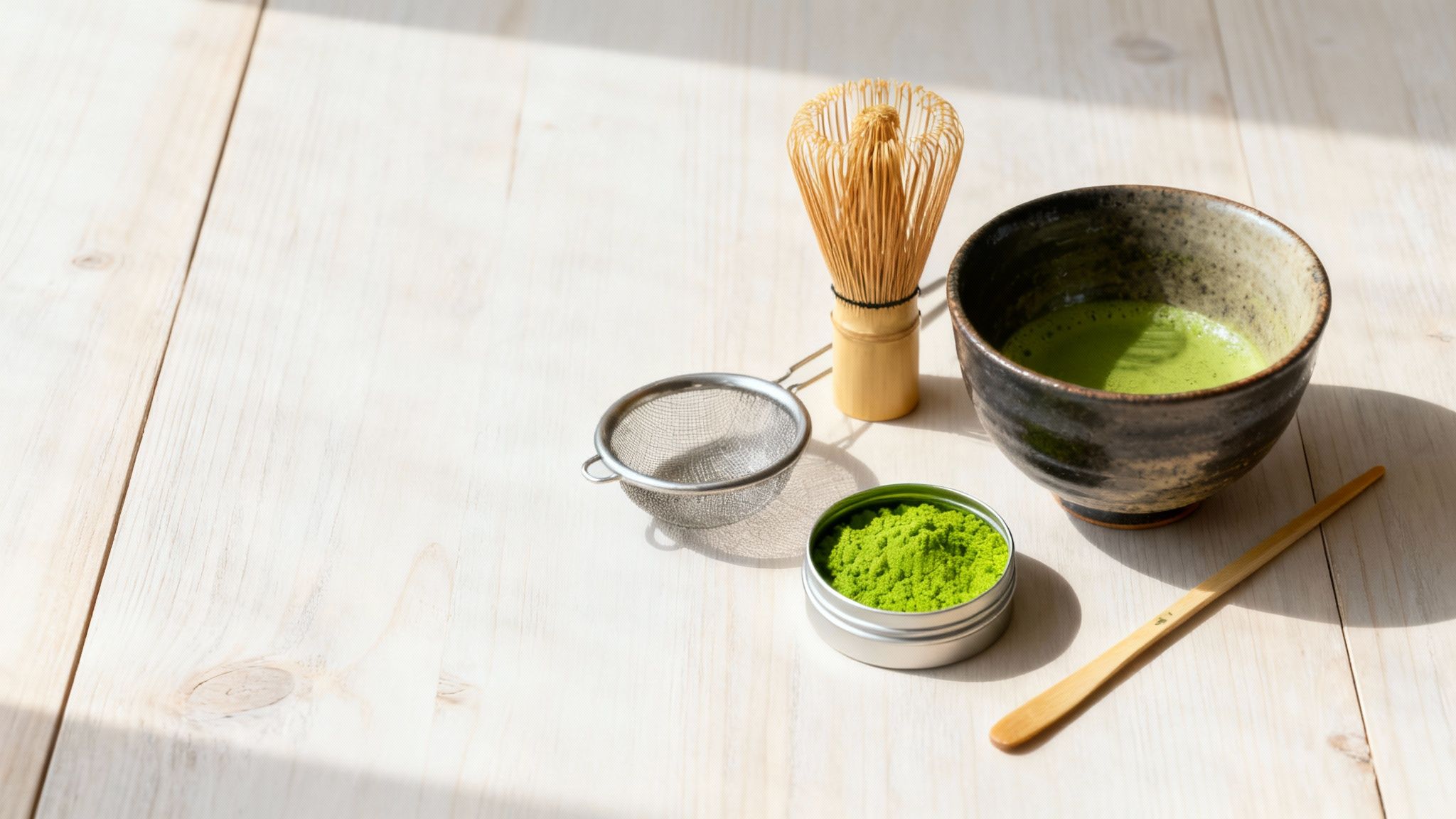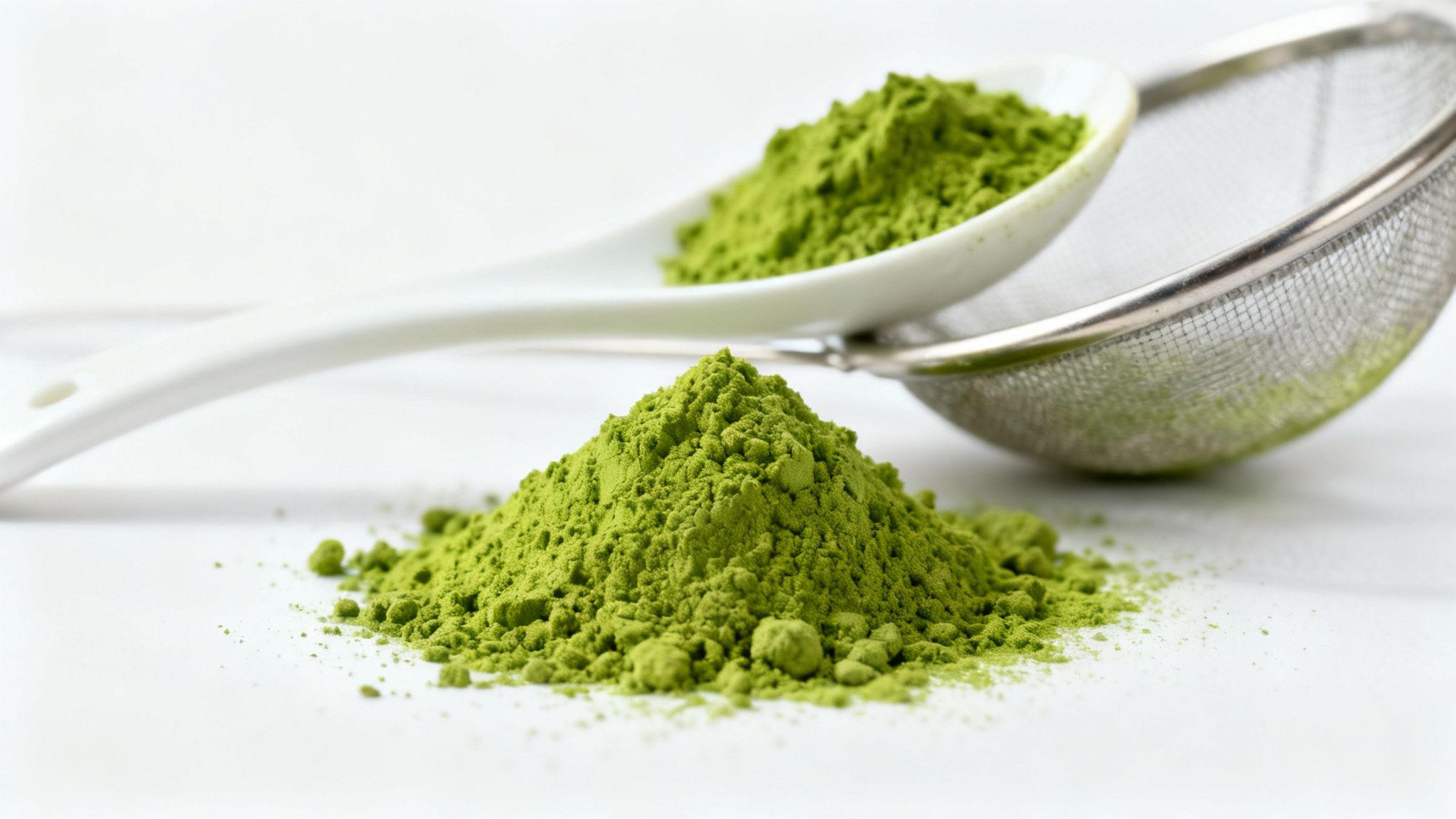Preparing matcha is more than just making a drink; it's a small, mindful ritual. The process is simple at its heart: sift high-quality green tea powder, whisk it with hot water using a bamboo whisk (chasen), and serve it in a special bowl (chawan). The whole point is to create a smooth, frothy texture that unlocks the tea’s vibrant, umami-rich flavour.
Discover the Mindful Art of Matcha Preparation

Welcome to the world of matcha. Think of it as a moment of calm focus in a busy day, rather than just another cup of tea. This guide will walk you through the traditional process, showing you that creating that perfect bowl of frothy, vibrant matcha is much easier than it looks.
Don't be intimidated. We'll explore what makes a good ceremonial grade matcha special and get to the bottom of why this ancient Japanese tradition has found such a passionate audience right here in the UK.
A Growing UK Tradition
Matcha's popularity has absolutely soared, moving from niche health food shops right into the mainstream cafes we visit every day. It's clearly more than a fleeting trend; it reflects a growing appreciation for its unique taste and undeniable wellness benefits.
The numbers don't lie. Between June and July 2025, matcha beverages were sold over 1.6 million times in the UK by more than 2,100 sellers, bringing in a gross merchandise value of over $7 million. London has really become the epicentre, accounting for about 76% of all UK matcha sales in that time. It's safe to say Britain is having a real matcha moment.
More Than Just a Drink
Beyond the lovely preparation ritual, matcha is prized for its health properties. Because you're consuming the entire tea leaf—ground into a fine powder—instead of just an infusion, you get a much more concentrated dose of antioxidants and nutrients.
The amino acid L-theanine, found in high concentrations in matcha, is known for promoting a state of relaxed alertness. This is why so many people feel a sustained, calm energy and focus, without the jitters you can get from coffee.
This unique combination of a meditative ritual and tangible wellness perks is really central to its appeal. If you're keen to learn more about the wider medicinal benefits of tea, there's a wealth of information out there to explore.
Assembling Your Essential Matcha Toolkit

To really get the best out of your matcha, having the right tools makes all the difference. This isn’t about being precious or collecting fancy gear; it’s about understanding how each item plays its part in creating that perfect, vibrant bowl of tea. Trust me, the right equipment turns the whole ritual from a task into a truly mindful and rewarding experience.
Let's start with the heart of any matcha set-up: the bamboo whisk, or chasen. Its beautiful, intricate design, usually with somewhere between 80 and 120 delicate tines, is perfectly engineered to aerate the tea. It’s this energetic whisking that gives you that signature, velvety froth we all look for in a top-notch matcha.
The Core Components
Next up is the matcha bowl, traditionally called a chawan. You’ll notice it’s wider and flatter on the bottom than your average teacup. This isn’t by accident. The shape gives you plenty of room to whisk properly without splashing, making it so much easier to get a lovely, consistent foam.
Then you have the traditional bamboo scoop, or chashaku. While a teaspoon will do in a pinch, the elegant curve of a chashaku is specifically designed to measure out the ideal amount of matcha powder—usually one to two scoops per serving.
And finally, something I consider non-negotiable: a fine-mesh sieve. Matcha powder is incredibly delicate and has a tendency to clump up because of static. Sifting it straight into your chawan before you add any water is the one true secret to a silky, lump-free drink every single time.
To give you a clearer picture, here’s a quick rundown of the traditional tools and what they do.
Your Essential Matcha Preparation Tools
| Tool Name | Japanese Name | Primary Function |
|---|---|---|
| Bamboo Whisk | Chasen | Aerates the tea to create a fine, velvety froth. |
| Matcha Bowl | Chawan | Provides ample space for effective whisking without splashes. |
| Bamboo Scoop | Chashaku | Measures the perfect serving of matcha powder. |
| Fine-Mesh Sieve | Furui | Breaks up clumps in the powder for a smooth texture. |
Each piece has a simple, yet vital role. When used together, they transform fine green powder and hot water into something truly special.
Key Takeaway: Sifting your matcha powder is the single most important step for achieving a smooth, clump-free consistency. Skipping this often leads to a gritty texture, no matter how well you whisk.
If you're just starting out, your first and most important investment should be a quality chasen. A well-made bamboo chasen matcha whisk will serve you well for a long time if you look after it, and it genuinely elevates your matcha game. While these tools are quite specific, building up your collection of other essential kitchen tools can open up a whole new world of culinary adventures.
Perfecting Your Whisking Technique

This is where the real art of making matcha comes alive. The difference between a gritty, disappointing drink and a smooth, vibrant bowl of tea all comes down to what you do in these next few moments. It's a satisfying little ritual that transforms simple ingredients into something truly special.
Before anything else, give your bowl (the chawan) a bit of attention. Pour in some hot water, give it a swirl for about 10 seconds, then tip it out. This simple act warms the ceramic, which is crucial for keeping your matcha at the perfect drinking temperature.
Next, a step I absolutely never skip: sifting. Matcha powder is incredibly fine and loves to clump together because of static. Pushing one to two scoops through a small sieve directly into your warm bowl gets rid of any lumps. Trust me, this is the secret to a perfectly smooth texture.
Mastering the Whisking Motion
Right, let's get whisking. To create that beautiful, stable foam, you need to forget about the gentle, circular stirring you'd use for a cake mix. It’s all about a rapid, energetic movement that comes from the wrist.
Think of it like you’re quickly drawing a 'W' or 'M' shape back and forth across the bottom of the bowl. This vigorous action whips air into the tea, creating that signature delicate froth. Keep your wrist loose and aim for a brisk pace for about 20 to 30 seconds, or until a lovely layer of fine bubbles covers the surface.
Pro Tip: The ideal water temperature for matcha is around 80°C (175°F). Boiling water will scorch the delicate tea leaves, leaving you with a bitter taste. If your kettle doesn’t have a temperature setting, just let it stand for a couple of minutes after boiling to cool down.
Of course, having the right tool for the job helps immensely. The traditional bamboo whisk, or chasen, is specifically designed for this task. You can find out more about why the matcha green tea bamboo whisk is so effective in our detailed guide.
Adjusting Your Brew to Taste
One of the best parts of making matcha at home is that you get to make it exactly how you like it. The ratio of powder to water is completely up to you.
For a traditional, thinner style known as usucha, a good starting point is about one gram of matcha (that’s one to two bamboo scoops) to 60-80ml of water.
If you’re after something much thicker and more intense, you could try making koicha. For this, you’d typically double the amount of matcha and use slightly less water. The result is a potent, almost syrupy brew with a deep, complex flavour. Have a play with the ratios to find what you enjoy most—it’s all about crafting a bowl that you find delicious.
How to Select High-Quality Matcha Powder

Of all the elements that go into a perfect bowl of matcha, the powder you choose is by far the most important. Getting this right is what separates a lacklustre, gritty brew from an exceptional one. Trust me, not all green powders are created equal, and it all comes down to understanding the grade.
For the traditional, whisked tea we’re making here, you absolutely must use ceremonial grade matcha. This is the top tier, made from the youngest, most tender tea leaves. They are carefully shade-grown to boost their chlorophyll and L-theanine content, which is the secret to that smooth, naturally sweet flavour profile we’re after.
You’ll also see culinary grade matcha out there. It’s made from older leaves and has a more robust, slightly bitter taste that’s designed to be balanced by other ingredients in lattes or baking. If you try to make a traditional tea with it, you’ll almost certainly be met with a disappointing, astringent flavour. You can dive deeper into the distinct types of matcha tea in our detailed guide.
Reading the Sensory Cues
So, how can you spot a top-tier ceremonial matcha before you even taste it? It’s time to trust your senses. A little bit of know-how goes a long way.
- Colour: First, look at the colour. It should be a vibrant, almost electric green. A dull, yellowish, or brownish hue is a dead giveaway of lower quality, oxidation, or old leaves.
- Texture: Feel the powder between your fingers. High-quality matcha is stone-ground into an incredibly fine powder that feels silky, almost like talc or cornflour.
- Aroma: Open the tin and take a sniff. It should have a fresh, sweet, and grassy scent. If it smells dusty or flat, it’s probably past its best.
- Taste: The defining characteristic of great matcha is a rich "umami" flavour. It’s that satisfying, savoury depth that perfectly balances the natural sweetness and vegetal notes.
It’s clear people are catching on to the importance of quality. The UK matcha tea market is booming, generating £61.8 million in 2024 alone. Interestingly, matcha powder itself holds the largest revenue share at over 55%, which shows just how many people are investing in great ingredients for their home rituals.
Key Takeaway: For the best traditional tea, always choose ceremonial grade matcha. Its vibrant green colour, fine texture, and sweet, umami-rich flavour are the hallmarks of a superior powder that will elevate your entire matcha experience.
Common Matcha Mistakes and How to Fix Them
Even the most seasoned matcha drinkers can get it wrong sometimes, so don't worry if your brew isn't quite perfect yet. Think of this as your go-to troubleshooting guide for the little things that can make a big difference.
The number one complaint we hear is about bitter matcha. If your tea tastes harsh and unpleasant, the culprit is almost always water that's far too hot. Pouring boiling water (100°C) directly onto the delicate powder will scorch it, killing all those lovely, sweet notes.
The Fix: Aim for water around 80°C (175°F). If you don't have a fancy temperature-controlled kettle, no problem. Just boil the water and let it sit for a couple of minutes to cool down before you pour.
Why Is My Matcha Lumpy?
Another common frustration is finding those stubborn little clumps of powder at the bottom of your bowl. No amount of furious whisking seems to break them down, leaving you with a gritty texture instead of a silky-smooth tea. This is usually down to a bit of static or moisture clumping the fine powder together.
Luckily, the solution is incredibly simple and makes a world of difference: sifting.
- What to do: Just push your matcha through a small, fine-mesh tea strainer directly into your bowl before you add any water.
- The result: This simple step breaks up any clumps and aerates the powder, guaranteeing a velvety consistency every single time.
Finally, if you’re struggling to create that beautiful, creamy froth, it’s probably time to look at your whisking technique. A gentle, circular stir just won't cut it – you need to inject some air into the mix.
The trick is to use a rapid, energetic motion from your wrist, almost like you're drawing a quick ‘W’ or ‘M’ shape back and forth. This vigorous movement whips air into the tea, building that signature layer of delicate foam. A few small tweaks like these are all it takes to get past the most common hurdles and on your way to a perfect bowl of matcha.
A Few Final Matcha-Making Questions
Even after you’ve got the basics down, a few questions always seem to pop up. Let’s tackle some of the most common ones to make sure you feel completely ready to start your matcha journey.
What’s the Best Water Temperature for Matcha?
This is a big one. You’ll want your water to be around 70-80°C (160-175°F).
If the water is too hot – especially if it’s at a rolling boil – you'll scorch the delicate tea powder. The result? A disappointingly bitter brew. If you don’t have a fancy kettle with temperature settings, no problem. Just boil your water and let it sit for a couple of minutes before you pour.
Our Top Tip: Getting the temperature right is probably the single most important step for flavour. Hotter water doesn't make for better matcha, it just makes for a bitter one. A little patience goes a long way.
How Should I Keep My Matcha Fresh?
Matcha is incredibly sensitive to the elements. Light, heat, and air are its enemies, and they'll quickly degrade its quality.
To keep that vibrant colour and fresh, grassy flavour, always store your matcha in an airtight container in the fridge. Once you've opened a tin, try to use it within a month or two. That’s when it’s at its absolute best.
At Jeeves & Jericho, we believe your daily ritual deserves the highest quality matcha. You can explore our premium, ethically sourced ceremonial grade matcha and start your own journey by visiting us at https://www.jeevesandjericho.com.


